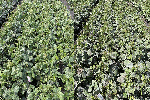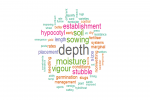-
 Biosecurity, 04 Aug 2022
Biosecurity, 04 Aug 2022Surveillance around the country
All states and territories conduct a range of surveillance activities throughout the year. The following provides a snapshot of projects and programs currently underway
-
 Biosecurity, 27 Apr 2022
Biosecurity, 27 Apr 2022Chemical residues in crops could harm safe grain status
The Australian Government’s National Residue Survey helps to manage the risk of chemical residue and environmental contaminants in food products. The NRS tests for residues of pesticides and environmental contaminants in 21 grains, pulses and oilseeds.
-
 Biosecurity, 25 Apr 2022
Biosecurity, 25 Apr 2022Brands, breeds, bright ideas – confirmation bias in action
In agriculture, confirmation bias is associated with a preference for certain brands, breeds, bright ideas and even accepting farming practices such as biosecurity. It is easy to disregard bias in decision-making if everything is seemingly working as it should for you and other farmers.
-
 Biosecurity, 20 Mar 2022
Biosecurity, 20 Mar 2022More aware after biosecurity scare
Following the submission of a single diseased head of wheat with an unusual expression of bunt disease symptoms, the University of Sydney’s Plant Breeding Institute at Narrabri had their harvest put on hold for 11 days. The site was effectively locked down following the suspected detection of the emergency plant disease.
-
 Biosecurity, 15 Jan 2022
Biosecurity, 15 Jan 2022Sentinels boost region-specific pest and disease monitoring
The iMapPESTS team successfully deployed its new and improved mobile surveillance unit, Sentinel 5, to Tamworth Agricultural Institute (TAI) in June 2021. In a collaboration between the South Australian Research and Development Institute and NSW Department of Primary Industries, the mobile surveillance unit was deployed at TAI to monitor high-priority insect pests and fungal pathogens for the grains industry.
-
 Biosecurity, 18 Oct 2021
Biosecurity, 18 Oct 2021Prevention is better than cure
Early detection and prevention are key components of a biosecurity plan that is designed to reduce the likelihood and impact of devastating pests, diseases and weeds entering farms. The Invasive Plants and Animals Policy Framework identifies the four key aspects of the Victorian Government’s overall approach to managing the different stages of an invasive species.
-
 Biosecurity, 17 Oct 2021
Biosecurity, 17 Oct 2021Pantry Blitz a biosecurity success for WA grains industry
Demonstrating the absence of exotic pests is vital to continue growing the local grain industry and maintaining access to export markets. The latest ‘Pantry Blitz’, an annual biosecurity surveillance project that focuses on various invasive stored product pests, has revealed no new exotic pests this year.
-
 Biosecurity, 30 Sep 2021
Biosecurity, 30 Sep 2021Biosecurity evolves to manage khapra beetle threat
The Australian grains industry is being protected from a highly invasive ‘hitchhiking’ pest through a multi-phased action plan
-
 Biosecurity, 28 May 2021
Biosecurity, 28 May 2021What happens when an exotic pest arrives in Australia?
When a new pest or disease is first detected in Australia, a decision must be made on whether it is feasible to eradicate it or whether we need to learn how to manage it. A recent example of an exotic pest that was determined unfeasible to be eradicated was fall armyworm, which arrived in northern Australia in early 2020.
-
 Biosecurity, 12 May 2021
Biosecurity, 12 May 2021Course offers free training
The ‘Growers – Pest Reporting and Responses’ course is the ideal starting point for grain growers wanting to improve their biosecurity game
-
GRDC News
+
GRDC News

Snail and slug baiting methods put to the test
A research project is underway to aid Australian grain growers to manage snail and slug...

Growers given edge in rust ‘arms race’
Grain growers will maintain access to wheat varieties with rust resistance and be able to...

Industry consultant honoured with GRDC award
The 2025 northern GRDC Seed of Light has been awarded to Independent Consultants Australia Network...

Victorian agronomist and scientist each win grains award
Agricultural consultant Cam Nicholson and research scientist Dr Audrey Delahunty each received awards this week...

Acid soil research priorities identified
A National Soil Acidity Workshop held in Adelaide in February has identified and prioritised transformational...

GRDC regional Updates to kick off in Cunderdin
Western Australian grain growers can learn about the latest research and innovations relevant to their...

Strategic grazing with virtual fencing a viable potential weed control option
Targeted grazing using near-commercial virtual fencing devices has emerged as an effective weed control solution...

Making sense of the weather
Recent investments by GRDC in enhanced seasonal forecast information have resulted in a productivity boost...
ADVERTISEMENT -
Agronomy
+
Agronomy

Impact of NVT extends beyond variety selection
The National Variety Trials (NVT) system adds value to the agricultural research pipeline in ways...

Celebrating 20 years of GRDC’s National Variety Trials
Established by GRDC in 2005, NVT has evolved into the largest coordinated variety trial network...

Advancing cereal yield frontiers
GRDC is investing in research to identify agronomic tactics to help growers achieve yield potential,...

The quest for the perfect rhizobia–legume matches
GRDC has made a groundbreaking investment in creating the world’s largest collection of rhizobia, significantly...

Frost research set to target ear architecture
After many years of hearing stories about wheat varieties with different-shaped ears being more tolerant...

Cell membranes key to promising frost approach
The ability of plant cell membranes to flex instead of breaking or bursting at low...

To plant, or not, on late summer rain?
Higher returns are possible from a farming system that can flexibly optimise sowing opportunities throughout...

Managing waterlogging is a long road travelled
Working with South Coast NRM on a GRDC-supported National Grower Network project, the Marold family...

World-first solution to combat spray drift saves growers time, money
The Weather and Networked Data (WAND) system, a pioneering Australian-developed weather data technology, has been...

Waving a WAND to boost spraying certainty
The Weather and Networked Data (WAND) system allows growers to plan their spraying operations with...
ADVERTISEMENT -
Grower stories
+
Grower stories

Time to reflect as growers weigh up mostly positive harvest results
Grain growers from across Australia report on how the season is progressing as they gear...

NVT reflect a ‘team Australia’ approach
For two decades, trial service providers have created the region-specific data on crop performance needed...

Lessons aplenty in levelling
The benefits of levelling melon holes were discussed when the Yarrie Lake Landcare Group travelled...

Opportunity knocks for mungbeans this season
Mungbeans have been exceptional this season for south-eastern Queensland growers Peter and Kylie Bach, with...

Futureproofing weed management
Data for future weed solutions is being collected by Terry Antonio and his SwarmBot

On-farm advocacy prompts national project
Trials testing long coleoptile wheat have had an unexpected benefit, showing that deep sowing can...

Winter canola proves profitable at Weatherboard
Ben Findlay’s farm near Weatherboard, Victoria, utilises ungrazed winter canola, specifically the hybrid RGT Nizza...

Growers networking to master faba beans
Faba bean growers are tapping the experience of researchers, agronomists and fellow growers to improve...
ADVERTISEMENT -
Weeds, pests and diseases
+
Weeds, pests and diseases

Diversity is a defence against weeds
A diverse crop sequence can cost-effectively help reduce the annual ryegrass population. From 2014 to...

Planning and timing the key to hitting summer weeds
Timing is a key factor in the control of summer weeds, which should be sprayed...

Growers warned of increased mouse activity
The National Mouse Group warns of increased mouse activity reports in the Darling Downs and...

Pressure building to find new control strategies for aphids
The need for an integrated strategy to control blue-green aphids has been heightened by the...

App helps mungbean growers manage powdery mildew
The PowderyMildewMBM app has been helping mungbean growers across Queensland and New South Wales better...

Rustproofing cereals to protect harvests
Wheat diseases cost Australian cereal growers about $1 billion a year. Stripe rust is the...

Eyes on exotic pests
Despite Australia’s stringent pre-border and border controls, exotic pests still pose a threat. Early detection...

Integrated approach to pests on-farm
To ensure pest control strategies are effective, it is crucial to diversify the approach taken...

Grains industry scores A-plus for chemical residue compliance
Australia’s grains industry has a 99.2 per cent compliance rate with national maximum residue limits...

EU changes residue limit for haloxyfop on canola
The EU has announced it intends to reduce the MRL for haloxyfop on canola from...
ADVERTISEMENT -
Crops
+
Crops

Hardy barley proves its worth in rotation trials
Long-term farming systems experiments support barley as a profitable inclusion in canola and wheat rotations

Award-winning crop takes topsy-turvy seasonal conditions in its stride
Minhamite grower Tim Whitehead has won a GRDC Hyper Yielding Crops initiative award for his...

Keys unlock pulse development stages
A growth stage key that ensures indeterminate pulse crops are measured consistently has been developed....

Legumes may push a system closer to yield potential
In high-yielding environments, adding more nitrogen fertiliser may not be enough to maximise returns in...

Understanding canola establishment to optimise yields
Establishment of any crop is foundational to its performance and, ultimately, its yield. A major...

Enquiring attitude opens opportunities
Have-a-go attitude is surprising Chloe Rout in the avenues and opportunities it can open for...

Brainstorming with other growers a path to progress
Minhamite grower Tim Whitehead has won a GRDC Hyper Yielding Crops initiative award for his...

Decline in wholegrain bread
Australian Dietary Guidelines recommend that Australian adults eat six servings of grains daily, preferably as...
ADVERTISEMENT -
Innovation
+
Innovation

Autonomy proves a game changer
Speaking at a GRDC/Society of Precision Agriculture Australia webinar, Tom Longmire said a SwarmFarm robot...

Are you ready for autonomy?
With automated on-farm solutions for farm tasks now available, it is worth considering if you...

Drought-tolerant crop research
A canola variety modified to tolerate the herbicide glyphosate has been placed on the Office...

120 years of wheat in 100 metres
An extraordinary set of Australian wheat varieties dating back 120 years is being grown at...

Grains steps up preparations for GHG monitoring
With the grains industry, like agriculture more broadly, facing increasing pressure to know its carbon...

Fostering high-impact innovation in heat tolerance
GRDC has long maintained an extensive investment portfolio looking to improve the heat tolerance of...

Vale Alan Robson – a champion for agricultural science
Alan Robson, foundation director of the Cooperative Research Centre for Legumes in Mediterranean Agriculture, has...

Research enthusiast sees value in ground-truthing
Seven years ago, a forward-thinking mixed farmer from southern New South Wales applied to become a...
ADVERTISEMENT -
Farm business
+
Farm business

Study tour unveils new perspectives
A GRDC study tour for grain growers and advisers to WeedSmart Week on the Eyre...

Building resilience in a mixed farming business
As we confront changes in climate, resilience of production systems and farm businesses is becoming...

Ten tips to reduce the risk of harvester fires this season
Recent GRDC Harvester Set-up Workshops run across Australia’s grain growing regions have highlighted the importance...

Selecting grain protectants this harvest
GRDC's latest cereal protectants offer enhanced pest management. Key for growers: rotating Spinosad, Deltamethrin, Fenitrothion,...

Give grain storage a pre-harvest health check
GRDC Grain Storage Extension team project lead Chris Warrick said the biggest challenge of storing...

Pest resistance raising the knowledge bar for stored grain
Ongoing research highlights the growing challenge of managing stored grain pests due to increasing insect...
ADVERTISEMENT